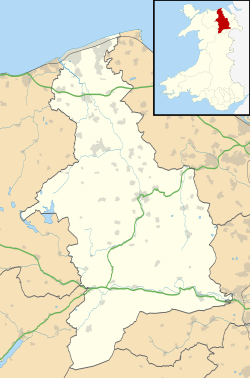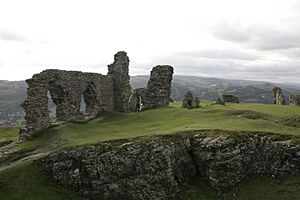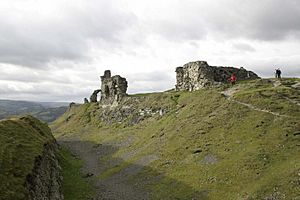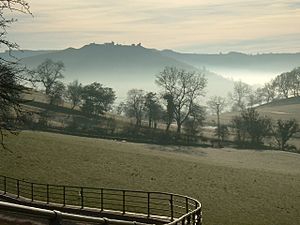Castell Dinas Brân facts for kids
Quick facts for kids Castell Dinas Brân |
|
|---|---|
| Near Llangollen, Denbighshire, in Wales | |
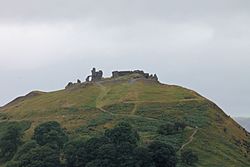
Castell Dinas Brân as seen from the Panorama Walk
|
|
|
Location within Denbighshire
|
|
| Coordinates | 52°58′45″N 3°09′34″W / 52.97922°N 3.15957°W |
| Grid reference | SJ 2224 4306 |
| Site information | |
| Owner | Cadw |
| Open to the public |
All year |
| Condition | ruinous |
| Site history | |
| Built | 13th century |
| Materials | stone |
| Fate | Abandoned in the 14th century |
| Events | Conquest of Wales |
Castell Dinas Brân is a medieval castle. It sits on top of a tall hill above the town of Llangollen in Denbighshire, Wales. The castle you see today was likely built in the 1260s. It was built by Gruffydd Maelor II, a prince from a region called Powys Fadog. Before this stone castle, there were other buildings on the site, including an Iron Age hillfort.
The name Dinas Brân can mean a few things. It might mean "the crow's fortress" or "fortress of Brân." Brân could be the name of a person or a nearby stream. People have also called it "Crow Castle" since the 1700s.
Contents
What Does the Name Dinas Brân Mean?
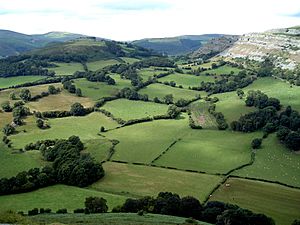
The name Dinas Brân has been talked about for a long time. Today, some people incorrectly translate it as "the City of Crows." The word dinas in old Welsh meant a protected area, not a city. Brân is the Welsh word for "crow" (singular). So, it could mean "the crow's fortress."
Another idea is that Brân was a person's name. Some legends say Brân was a prince from Cornwall. Others suggest it was named after King Brân Fendigaid, a Celtic god.
A different idea is that Brân refers to a mountain stream. This stream started in the Eglwyseg Rocks and flowed at the bottom of the hill. The stream was called Brân because its water was black.
The castle is also known in English as "Crow Castle." This name has been used since at least the 1700s. By the mid-1800s, most people in Llangollen used this name. There was even an inn in Llangollen called "Crow Castle."
History of the Castle
Early Times: The Iron Age
Around 600 BCE, during the British Iron Age, a large hillfort was built on top of the hill where Dinas Brân now stands. This was built by a Celtic tribe called the Ordovices. They built an earthen wall around their homes. This wall probably had a wooden fence on top. They also dug a very deep ditch to protect the easier-to-reach southern side of the hill.
This hillfort was one of many strongholds the Ordovices had in North Wales. Other nearby hillforts included Caer Drewyn and Moel y Gaer.
After the Romans: Early Medieval Period
The first structure that might have been at Dinas Brân could have belonged to Elisedd ap Gwylog in the 700s. Elisedd was a ruler during the time when Anglo-Saxons were settling in Britain. He helped start the Kingdom of Powys. However, we haven't found any proof from archaeology that a building from this time existed here.
Later Medieval Period: Stone Castle
Dinas Brân might have been a fort in the Kingdom of Powys. When its last prince, Gruffydd Maelor, died in 1191, his kingdom split into two parts. His son, Madog ap Gruffydd Maelor, ruled the northern part, Powys Fadog. He might have ruled from Dinas Brân. Any castle here at that time would have been made of wood. It probably had a wooden fence around a main hall and other buildings. Old records say this early wooden castle was destroyed by fire.
After the wooden castle burned down, Gruffydd II ap Madog, Lord of Dinas Bran, Madog's son, rebuilt Dinas Brân using stone. This happened around the 1260s. At this time, Gruffydd II ap Madog was a friend of Prince Llywelyn ap Gruffudd, who was the Prince of Wales. Powys was like a "buffer state" between Llywelyn's lands in Gwynedd and England. Dinas Brân was one of several castles being built after the Treaty of Montgomery. This treaty had made Wales safe for Llywelyn, free from English interference.
The peace between Llywelyn and Edward I did not last long. In 1277, Edward started the conquest of North Wales. Two of Gruffudd's sons quickly made peace with Edward. However, their surrender papers show that Dinas Brân was not under their control. Henry de Lacy, Earl of Lincoln was sent to capture Dinas Brân. When he arrived, he was told that the castle's defenders had left the castle and set it on fire. They might have done this because they didn't think they could defend it. They didn't want the English to capture it in good condition.
Even though it was set on fire, the castle was not badly damaged. The Earl of Lincoln suggested to Edward that the castle should be fixed and guarded. The English held the castle until at least the Treaty of Aberconwy. After this, Llywelyn asked for peace and ordered some repairs to the castle.
When the war started again in 1282, we don't know much about the castle's history. It might have been taken back by the Welsh, but eventually, it fell to the English. After the war ended, much of Powys Fadog, including the castle, was given to John de Warenne. Instead of rebuilding Dinas Brân, De Warenne decided to build a new castle at Holt. Dinas Brân was then left to fall into ruin.
How the Castle Was Built
Dinas Brân has rectangular stone walls. The longer sides run from east to west. The northern wall is protected by a very steep natural slope. The walls on the southern and eastern sides, which are less steep, have an extra deep ditch dug into the rock. This ditch is about 20 feet (6 meters) deep.
At the south-eastern corner, where the ditch is deepest, stood the keep. This was the strongest part of the castle. It had two floors and its own protected entrance. Next to the keep, at the north-eastern corner, was a gatehouse. You would have reached it by a wooden bridge over the ditch. The keep also overlooked this bridge, so archers could guard the entrance. The gatehouse had two towers on either side of a covered path into the castle courtyard.
The Great Hall was on the castle's southern side. This was a large room for eating and meeting visitors. Its big windows still look south across the valley. An arched doorway led from this room to what used to be the kitchens. There was also a special tower called the Welsh Tower. This tower was shaped like a 'D' and stuck out from the castle wall into the ditch. It gave archers a clear view of anyone trying to attack the southern wall. This tower likely had three floors with living areas on the upper levels.
In the south-western corner was a Postern gate. This was an extra exit from the castle. It was used during a siege to let the soldiers rush out and attack their enemies. You can still see parts of the arch and the slot for the door's drawbar.
Inside the castle walls, there would have been stables, workshops, storage buildings, and maybe a chapel. But since these were made of wood, nothing remains above ground today.
Legends and Stories
Even though we don't have many historical records for Dinas Brân, there are many myths and legends about this ancient place.
The famous Welsh song 'Myfanwy' was written in 1875. Its words were likely inspired by a love story from the 1300s. This story was about Myfanwy Fychan of Castell Dinas Brân and the poet Hywel ab Einion.
The castle first appears in a story from the 1100s called "Fouke le Fitz Waryn." In this tale, the castle, called "Chastiel Bran," is already a ruin. The story tells of a proud knight, Payn Peveril, who hears that no one dares to stay overnight in the castle ruins because of evil spirits. Payn and 15 knights decide to stay the night. A storm starts, and a giant named Gogmagog appears. Payn fights the giant and eventually stabs him. As the giant is dying, he tells Payn about King Brân. King Brân had built the castle to try and defeat the giant. But King Brân had to run away, and since then, the giant had scared the whole land for many years. The giant also mentions a huge treasure of golden statues hidden at Dinas Brân, but he dies before he can say where it is.
Keeping the Castle Safe
The castle is an important ancient monument. It is owned and looked after by Denbighshire council with help from Cadw, a Welsh government group that cares for historic sites. It is open all year round for visitors. Because the paths up to the castle are steep and exposed, it's a good idea to wear sturdy walking shoes and warm, waterproof clothes when you visit.
The Hill's Rocks
The noticeable hill where Dinas Brân was built is about 1,054 feet (321.4 meters) high. It is made of thin layers of muddy rocks. These rocks are from a very old time period called the Silurian period, which was about 423 to 427 million years ago. The castle builders used these rocks to construct the castle. You can still see pieces of these rocks in the ditches around the castle.
See also
 In Spanish: Castillo Dinas Brân para niños
In Spanish: Castillo Dinas Brân para niños


